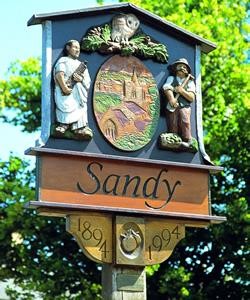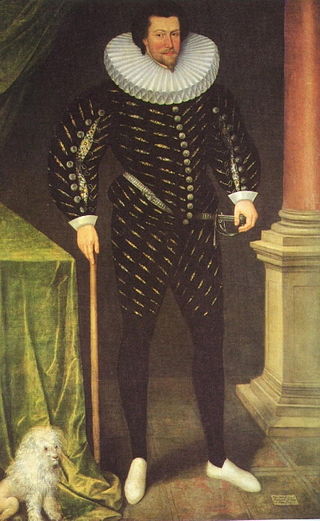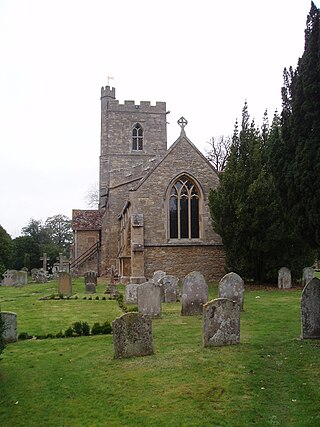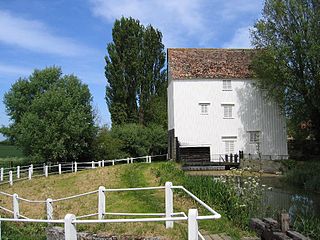
St Neots is a town and civil parish in the Huntingdonshire district of Cambridgeshire, England. It is 18 miles (29 km) west of Cambridge. The areas of Eynesbury, Eaton Ford and Eaton Socon form part of the town.

Eye is a village in the unitary authority area of Peterborough, in the ceremonial county of Cambridgeshire, England. The village is 4.5 miles (7 km) south from Crowland. The hamlet of Eye Green is 1⁄2 mile to the north, separated by the A47 trunk road.

Sandy is a town and civil parish in Central Bedfordshire, England. It lies 8 miles (13 km) to the east of Bedford, 18 miles (29 km) to the south west of Cambridge and 43 miles (69 km) north of Central London. It had a population of 12,171 at the 2021 census.

Duke of Bedford is a title that has been created six times in the Peerage of England. The first and second creations came in 1414 and 1433 respectively, both in favour of Henry IV's third son, John, who later served as regent of France. He was made Earl of Kendal at the same time and was made Earl of Richmond later the same year. The titles became extinct on his death in 1435. The third creation came in 1470 in favour of George Neville, nephew of Warwick the Kingmaker. He was deprived of the title by Act of Parliament in 1478. The fourth creation came in 1478 in favour of George, the third son of Edward IV. He died the following year at the age of two. The fifth creation came in 1485 in favour of Jasper Tudor, half-brother of Henry VI and uncle of Henry VII. He had already been created Earl of Pembroke in 1452. However, as he was a Lancastrian, his title was forfeited between 1461 and 1485 during the predominance of the House of York. He regained the earldom in 1485 when his nephew Henry VII came to the throne and was elevated to the dukedom the same year. He had no legitimate children and the titles became extinct on his death in 1495.

William Russell, 1st Baron Russell of Thornhaugh was an English nobleman, politician, peer, and knight. His birthdate is uncertain, with some records showing that he was born as early as 1553, some as late as 1563. He was educated at Magdalen College, Oxford. After spending a few years abroad, he went back to Ireland in 1580, and having seen some service in that country, he was knighted in September 1581.

Bromham is a village and civil parish in the Borough of Bedford in Bedfordshire, England, situated around 3 miles (4.8 km) west of Bedford town centre.

Lode is a small village in East Cambridgeshire on the southern edge of The Fens. It lies just north of the B1102 between Quy and Swaffham Bulbeck, 8 miles (13 km) to the north east of Cambridge.

Tickenham is a village and civil parish near Clevedon and Nailsea in North Somerset, England. The parish has a population of 910. It has a primary school, a village hall and a garden centre, but no shops, although it formerly had a post office.

Little Paxton in Cambridgeshire, England is a village and civil parish that lies 5 miles (8.0 km) south of Huntingdon and 1.7 miles (2.7 km) north of St Neots. It is in the district and historic county of Huntingdonshire. Until the 1970s it was a minor village and the church was under threat of closure. The building of a housing estate and a junior school revived its fortunes and the establishment of the Paxton Pits Nature Reserve around part of the nearby gravel pits has brought visitors to the village.

Warboys is a large village and civil parish in the Huntingdonshire district of Cambridgeshire, England, 7 miles (11 km) north-east of Huntingdon.

Wansford is a village straddling the City of Peterborough and Huntingdonshire districts in the ceremonial county of Cambridgeshire, England. It had a population of 506 at the 2021 Census. It is situated 7 miles (11 km) west of Peterborough and 8 miles (13 km) miles south of Stamford. It is close to the county boundary with both Lincolnshire and Northamptonshire. The village is also located close to the A1 road and was on the route of the original Great North Road before the modern A1 was built. The village has since been bypassed by the A1 but the former Great North Road still exists through the village.

Thorney is a village in the Peterborough unitary authority in the ceremonial county of Cambridgeshire, England. Located around eight miles (13 km) east of Peterborough city centre, on the A47.

Asthall or Asthal is a village and civil parish on the River Windrush in Oxfordshire, about 6 miles (10 km) west of Witney. It includes the hamlets of Asthall Leigh, Field Assarts, Stonelands, Worsham and part of Fordwells. The 2011 Census recorded the parish's population as 252. Asthall village is just south of the River Windrush, which also forms the south-eastern part of its boundary. The remainder of the parish including all of its hamlets lie north of the river. A minor road through Fordwells forms most of the parish's northern boundary. Most of the remainder of the parish's boundary is formed by field boundaries.

Thorney Abbey, now the Church of St Mary and St Botolph, was a medieval monastic house established on the island of Thorney in The Fens of Cambridgeshire, England.

The A6121 is a short cross-country road in the counties of Lincolnshire and Rutland, England. It forms the principal route between Bourne and Stamford and the A1 in Lincolnshire, continuing on through Ketton in Rutland to its junction with the A47 at Morcott. Its south-western end is at 52°35.5860′N0°38.0820′W and its north-eastern end is at 52°45.9120′N0°24.0660′W. The road has increased in importance with the rapid expansion of housing in this part of South Kesteven.

Bedford Purlieus is a 211-hectare (520-acre) ancient woodland in Cambridgeshire, in the United Kingdom. It is a national nature reserve and Site of Special Scientific Interest owned and managed by the Forestry Commission. In Thornhaugh civil parish, 10 km (6.2 mi) south of Stamford and 14 km (8.7 mi) west of Peterborough, the wood is within the Peterborough unitary authority area of Cambridgeshire, and borders Northamptonshire. In Roman times it was an iron smelting centre, during the medieval period it was in the Royal Forest of Rockingham, and later it became part of the estates of the Duke of Bedford. Bedford Purlieus appears to have been continuously wooded at least from Roman times, and probably since the ice receded. The woodland may have the richest range of vascular plants of any English lowland wood. It acquired particular significance in the 1970s as an early subject for the historical approach to ecology and woodland management.

Garford is a village and civil parish about 4 miles (6.4 km) west of Abingdon. It was part of Berkshire until the 1974 boundary changes transferred it to Oxfordshire. The parish is bounded by the River Ock to the north, by two tributaries of the Ock to the south, and by field boundaries and the road between Kingston Bagpuize and West Hanney to the west. The 2011 Census recorded the parish's population as 229.

Duddington is a village and former civil parish, now in the parish of Duddington-with-Fineshade, in the North Northamptonshire district, in the ceremonial county of Northamptonshire, England. It is by the junction of the A47 and A43 roads, and is 9 kilometres (6 mi) southwest of the town of Stamford. The village is on the east bank of the River Welland which is the county boundary of Rutland. In 1961 the parish had a population of 184.

Chesterton is a village and civil parish on Gagle Brook, a tributary of the Langford Brook in north Oxfordshire. The village is about 1+1⁄2 miles (2.4 km) southwest of the market town of Bicester. The village has sometimes been called Great Chesterton to distinguish it from the hamlet of Little Chesterton, about 3⁄4 mile (1.2 km) to the south in the same parish. The 2011 Census recorded the parish population as 850.

Bretton is a settlement and civil parish on the north western edge of Peterborough, in the Peterborough district, in the ceremonial county of Cambridgeshire, England. Bretton has been designed as a green environment; the major roads are tree-lined and there are several large parks and playing fields. It consists of two main areas; North Bretton and South Bretton, these are divided by Bretton Centre. North Bretton has the larger population and is home to the industrial estates and most leisure facilities as well as the Crematorium. The main entrance to Milton Hall is from Bretton Way in South Bretton and Nene Park is accessed via an under pass beneath the A47.























